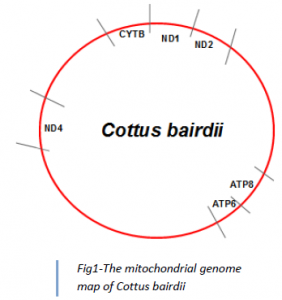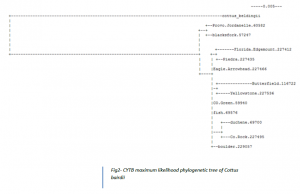Sun Yeong Oh and Dr. Dennis Shiozawa, Department of Biology
The goal for this project was to evaluate the genetic relationships of the freshwater sculpin, Cottus bairdii, in Butterfield Springs, Nevada, with other populations of C. bairdii. We planned to examine several mitochondrial genes, ND1, ND2, and the control region, to identify the most likely origin of this population. We hypothesized that these sculpins were from Colorado River Basin as Scoppettone speculated (Scoppettone, Rissler & Shea, 2004).
After much discussion, we decided that CYTB region will be a better choice than control region (Fig1). I selected 21 populations of C. bairdii from the Colorado River and Bonneville River. We extracted them. The ND1, ND2, and CYTB regions were amplified with the polymerase chain reaction (PCR). I used internal primers to amplify these genes in two sections. The samples of DNA were submitted to Brigham Young University DNA Sequencing Center and were sequenced on an ABI 377 automated sequencer. The sequences were imported into Sequencher 4.8, where they were aligned and trimmed.
Throughout this project, I had many problems. The main problem that I had to face was that primers of CYTB were not working well with sculpin. At first, I was only able to get DNA for 8 populations out of 21 populations. At first, I didn’t know if it was the extraction that went wrong or the gel or the other parts of the project that was causing this problem. After about 6 different tries and three different sets of primers, I was able to get DNA for 13 populations. Since CYTB is about 1,141 base pairs, I realized that I will get a better result if I divide the region into two and use different primers for each region.
After I aligned and trimmed all the sequences, I generated phylogenetic trees with maximum likelihood and Bayesian programs. Cottus beldingii was used as an outgroup and bootstrap values were used in Bayesian to give estimates of the percentage of relativeness between populations. I generated two trees for each program: ATPase8&6-ND4-ND1-ND2-concatenated and CYTB. Bayesian trees did not give much information on the origin of C. bairdii. It showed polytomies, which meant that evolutionary relationships cannot be resolved. However, the CYTB maximum likelihood showed better result.
The CYTB maximum likelihood tree shows some evidence that Butterfield C.bairdii originated from Colorado Basin (Fig 2). However, I need more evidence to conclude that they are actually from Colorado River Basin. In order to do that, we must get the whole mitochondrial genome. Next Gen Sequencing (NGS) will replace Sanger Sequencing to get more DNA efficiently. This will give more information on where these Butterfield sculpins came from.
Even though this project did not give me the result that I wanted, from looking at the maximum likelihood tree (Fig 2), it shows some evidence that Butterfield sculpins are from Colorado River Basin. In addition, this project taught me a lot about polymerase chain reaction, extracting, big dye, primers and etc.
Despite of not able to complete this project and get the result that I wanted, I am looking forward to continue working on it. I will be learning Next Gen Sequencing techniques this semester and I am hoping that this will help me to get better evidence to show how all these sculpins are related to each other.
References
- Scoppettone, G.G., Rissler, P.H., & Shea, S. (2004). A fish survey of the white river, Nevada. Western North American Naturalist, 64(1), 45-52.


